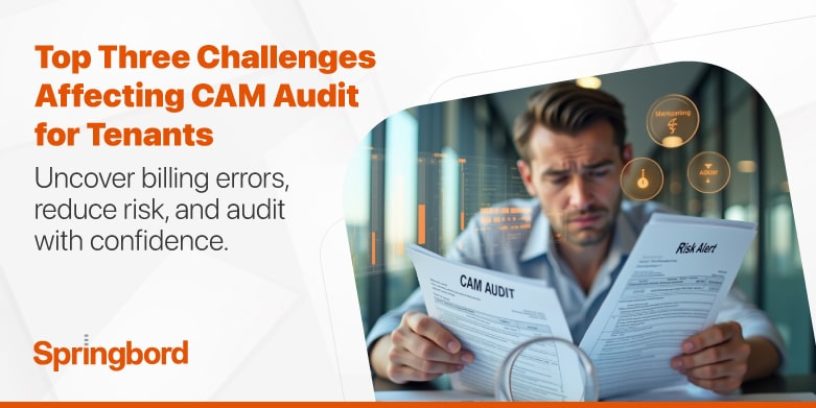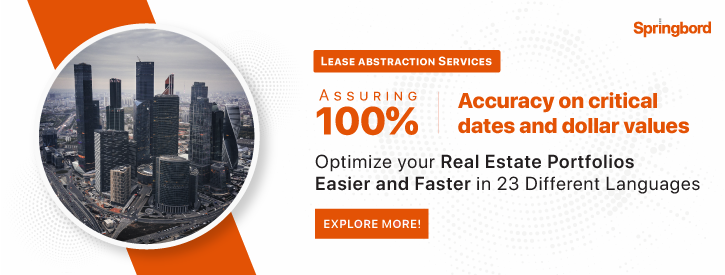 Read time 3 min
Read time 3 minIntroduction: Why CAM Charges Matter
Commercial lease tenants are required to pay Common Area Maintenance (CAM) charges, which cover the maintenance of usable common areas within the property. It is typically calculated as the tenant’s pro-rata share of the operating expense.
While CAM expenses are important for the upkeep of the property—which is mutually beneficial for both tenant and landlord—the lack of standard practices and broad definitions of CAM expenses have made CAM costs a major point of contention.
Because of this complexity, many tenants now turn to outsourced CAM audit services to ensure transparency, validate calculations, and avoid unnecessary overcharges.
CAM Audit: A Tool for Transparency
This is why over the years, to ensure accountability and transparency, many commercial leases now grant express audit rights to the tenants. This allows you to assess the landlord’s books and audit the items included as CAM charges and verify the accuracy of the calculation.
While CAM audit is an imperative process that can help uncover any discrepancies, wrongful practices, or miscalculations, it is an increasingly challenging and complex task. Let’s look at what makes the process a tedious one and how you can overcome these hurdles.
🚧 The Top Three Challenges in CAM Audits
1. Not choosing the right service provider
Considering the complexities of accounting practices and commercial leases, CAM audit can be quite tedious and challenging.
Not having the right partner to conduct the audit can derail the entire effort. The review process requires gathering a variety of documentation from the landlord and assessing various parameters to be able to identify gaps and prepare a detailed audit report. In-depth knowledge of commercial lease structures, CAM expenses and calculation, and accounting practices is a must for conducting these audits efficiently.
Plus, uncovering landlord errors and questioning their calculation requires that audits should be performed by professional and experienced firms to avoid any further conflicts and also errors in audits.
2. Lack of comprehensive coverage
CAM audit goes beyond simply checking the calculations, it entails conducting a comprehensive review of CAM charges. From comparing invoices with the lease terms to determining fair pricing to identifying any erroneous/hidden expenses to ensuring invoices are accurate and in line with lease terms.
Skipping any of these steps would make the entire process ineffective. Lack of comprehensive coverage often leads to an inability to accurately uncover overcharges or identify billing discrepancies, making it difficult to identify present and future occupancy cost risks and alleviate them.
3. Not engaging professionals at the right time
In many cases, tenants fail to ask for detailed statements from the landlord on time and delay raising an issue in case of improper CAM charges. In such cases, in many states, tenants may not only lose the right to appeal but also not have any option to challenge the landlord due to state-specific statute of limitations governing these disputes.
This often leads to unresolved issues but also tenants being obligated to pay the inflated operating expenses. It is therefore imperative to engage audit professionals early in the process.

Partnering with a specialized service provider can help contain occupancy costs through the identification of recovery opportunities, billing inaccuracies, and discrepancies with the lease terms and unauthorized charges.
How Springbord Can Help
At Springbord we have been helping commercial tenants of all sizes thoroughly examine CAM expenses negotiate refund and ensure comprehensive and substantive reporting in case of billing inaccuracies.
To know more about our CAM audit services and how we can help minimize financial risk and expedite dispute settlement, connect with us today!
Frequently Asked Questions (FAQs)
1. What makes CAM audits so complex for commercial tenants?
CAM audits require a deep understanding of lease agreements, accounting standards, and operating expense structures. The lack of standard definitions and landlord-specific calculations makes it difficult for tenants to validate charges without professional assistance.
2. Why is it important to conduct a comprehensive CAM audit instead of just reviewing totals?
A surface-level review may miss hidden or erroneous charges. A thorough audit includes verifying invoice accuracy, comparing costs with lease terms, identifying unauthorized expenses, and determining fair pricing.
3. What happens if tenants delay engaging audit professionals?
Delayed audits can result in missing the legal window to dispute incorrect charges. Many states have statutes of limitations, which, if missed, may prevent tenants from appealing or recovering overpayments.
4. What are typical expenses included in CAM charges?
Common CAM charges include cleaning services, landscaping, parking lot maintenance, security, elevator repairs, HVAC servicing, and property management fees. These vary based on lease agreements.
5. How often should a CAM audit be conducted?
Typically, tenants review CAM charges annually—after receiving the landlord’s reconciliation statement. However, it’s wise to conduct a professional audit every 1–2 years or when major cost changes occur.
6. Can CAM audits help reduce occupancy costs?
Yes. CAM audits often uncover overcharges, miscalculations, or non-recoverable expenses. Correcting these errors can lead to refunds, adjustments, and long-term cost savings.
7. What should tenants look for in a CAM audit service provider?
Look for providers with expertise in commercial leases, strong accounting knowledge, experience dealing with landlords, and a history of identifying recovery opportunities and ensuring compliance with lease terms.







